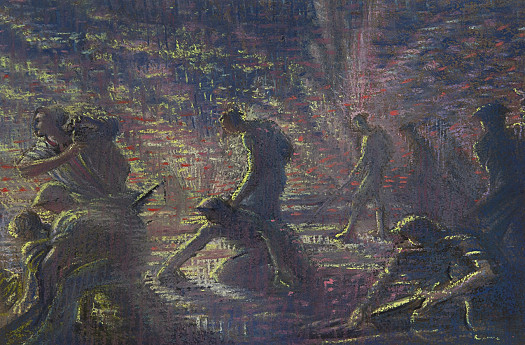Thomas Monnington was born in Westminster, London, on 2 October 1902, the younger son of the barrister, Walter Monnington, and his wife, Catherine (née Brown), who had trained as a painter in Paris. He grew up at Seaford, Sussex, and was educated at St Peter’s School, Seaford, and Brunswick School, Haywards Heath.
However, at the age of 12, he developed heart trouble, and was invalided for a year, during which time he concentrated on his talent for drawing and painting, encouraged by his mother. He then spent 18 months at a farm school near Ross-on-Wye, Herefordshire.
Monnington spent a brief period of 1917 at the London School of Art before he enrolled at the Slade School of Fine Art in January 1918. Of his teachers, Henry Tonks proved especially influential on his development, and encouraged him to specialise in decorative painting.
In 1922, Monnington won the scholarship in decorative painting offered by the British School at Rome. In the following year, he arrived in Italy and spent much of his time travelling in Tuscany and umbria, absorbing the influence of the work of artists of the Quattrocento. In 1924, he married the painter, and fellow Rome Scholar, Winifred Knights in Rome; they would have one son. They rented the top floor of a villa in Piediluco, umbria, and he began to paint Allegory (Tate), the masterpiece of his early period. In April to October 1925, another of his paintings, entitled Winter, and its cartoon were exhibited at the International Exhibition of Modern and Decorative Industrial Art, held at the Grand Palais in Paris.
Late in 1925, the Monningtons returned to England and lived initially at 33a Oxford Road, Putney. Thomas taught part-time at the Royal College of Art, and began to work on commissions for murals for St Stephen’s Hall, Westminster (1926-28), and the new Bank of England (1928-37). In 1926, he joined the Faculty of Painting of the British School at Rome.
In March 1928, the Monningtons moved into Studio A, 1 The Vale, the ground floor of Tonks’s house in Chelsea. Thomas joined the NEAC in 1929, but resigned two years later, having not exhibited there. Instead, in 1931, he began to exhibit at the Royal Academy of Arts, and that became the main showcase for a range of his work (including portraits), and gradually the centre of his professional life. Immediately, he was elected an associate of the RA and was appointed first assistant teacher at the RA Schools (until 1939). In 1938, he became a full Royal Academician.
Following the death of Tonks in 1937, he and his family had moved to Leyswood, Groombridge, Tunbridge Wells, Kent. The local landscape would inspired much of his later work.
On the outbreak of the Second World War in 1939, Monnington joined the design team of the Ministry of Camouflage in Leamington Spa, and became responsible for the camouflage of aircraft production airfields. Then, from November 1943, he worked as an official war artist with the Royal Air Force. He documented the war from the air and undertook further commissions from the Ministry of Air Transport.
When the war ended, Monnington began to teach at Camberwell School of Arts and Crafts (until 1949), and became a member of the Executive Committee of the British School at Rome (until 1972), and for a period was the Chairman of its Faculty of Painting (1948-67). Between 1949 and 1967, he also taught at the Slade School. His first wife, Winifred Knights, died in 1947 and, later the same year, he married Evelyn Hunt, the daughter of a mining engineer and silver prospector. They would have one son.
By the late 1940s, Monnington had changed approach, and was producing geometric, abstract compositions, both as easel paintings and decorative schemes. It remained grounded in his love of early Italian art, but was also influenced by his wartime experiences and his scientific interests. Major projects in the later style include the ceilings of the Conference Hall in Vincent Harris’s Council House, in Bristol (1954-56), and the Mary Harris Memorial Chapel, Exeter University (1956-58).
During the 1960s, Monnington was appointed to a number of administrative positions, including a Trustee of the British Museum (1963-69). They culminated in his becoming President of the Royal Academy in 1966, a role that he undertook most effectively, by helping to turn around the institution’s ailing fortunes. Among other honours, he was knighted in 1967. He died in office in London on 7 January 1976. A memorial exhibition was held at the Royal Academy in 1977.
His work is represented in numerous public collections, including the Imperial War Museums, Tate and the V&A.
Further reading:
Judy Egerton, ‘Monnington, Sir (Walter) Thomas (1902-1976)’, H C G Matthew and Brian Harrison (eds), Oxford Dictionary of National Biography, Oxford University Press, 2004,
https://doi.org/10.1093/ref:odnb/31455


